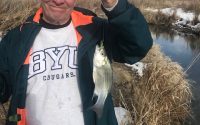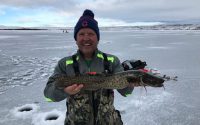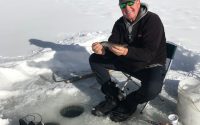Finding Striper “Boils”
 A common story from friends and readers of this column is as follows: “We went down to Lake Powell and all we wanted to see was a striper boil. Instead, we struggled to catch fish and didn’t see a single boil all week.”
A common story from friends and readers of this column is as follows: “We went down to Lake Powell and all we wanted to see was a striper boil. Instead, we struggled to catch fish and didn’t see a single boil all week.”
Allow me to help you understand the baitfish/predator relationship on Lake Powell and hopefully get you better prepared for the next time you find yourself trying to locate stripers in the fall.
Mike Tuvell (Provo resident) and I fished a team bass tournament towards the middle of October and spent the better part of 4 days on the water. Having prepared ourselves for the potential of striper boils, we launched and headed toward the main channel to find small coves that might hold large and smallmouth bass – if there were stripers present it would be a bonus.
Not Quite a Boil
The first thing we noticed after entering a small cove was the quiet. No wind, waves, boats or campers took away from the tranquility of the moment. As we carefully followed the shoreline into and around the cove, we both noticed the water in the center seems a little “off”. By that I mean the area towards the center of the cove seemed as if it were home to some bubbling springs. As we pressed towards the center, we realized that threadfin shad (the source of the bubbles) were “pocking” the water as theyfed on plankton.
We watched for a minute or two then returned to the shoreline to continue casting for bass. Within a few minutes, a splash took our attention back to the center of the cove and we realized that other game fish had located the school of shad. There was no boil, no frenzied rush to attack the school of shad, just a splash to two that told us something was about to happen.
I threw a topwater lure into the middle of the shad, and as I retrieved the lure, a huge splash startled me and a 4-pound striper inhaled my lure and began taking line. As I played the fish, more stripers joined in and all of a sudden we had a “mini” striper boil that was started (in part) by my cast into that school of shad.
The Striper – Baitfish Relationship

There is a definite relationship between prey and predator in Lake Powell. Baitfish feel secure when they are in large schools. Stripers search for and locate schools of shad but do not continuously attack. At times, of course, stripers come alive and literally churn hundreds of square yards of water in a cove in a frenzied chase to the bitter end. But, more times than not, stripers rest around and beneath schools of shad and wait for external forces to wake them up and get them in the mood to feed.
Though we didn’t see a single “all-out” striper boil in our four days on the water, we were able to “start” mini boils by finding schools of shad pocking the surface and throwing lures into the school, scattering the schools and motivating the stripers to take up the chase.
How to Find Striper Boils
Most of the striper boils in Lake Powell have ended for 2017. However, mini boils as I have described in this column will continue through November, unless it gets too cold. I’ve seen boils in 60-degree water but they are few and far between.
If you can get to Lake Powell this fall and want to find stripers, here are three ways that should help.
- Move in and out of deep canyons and small coves off the main channel looking for schools of shad near the surface.
- Look for crows and ravens on the shoreline (they will eat baitfish that are pushed onto the bank by hungry stripers).
- Throw lures into the schools of shad to stir them up and wake up resting stripers.
The stripers are healthy and make wonderful meat for the freezer. Be patient, observant, and tenacious as you locate schools of shad. And, in the end you will be rewarded with some incredible action. Good Luck!










